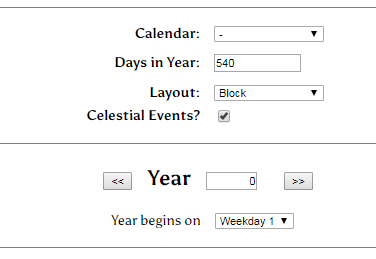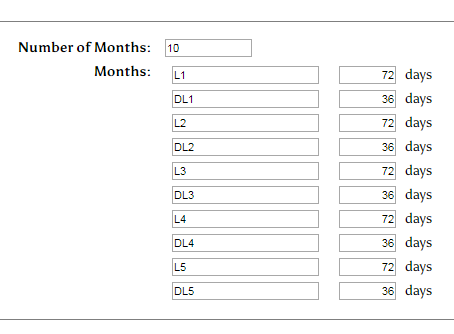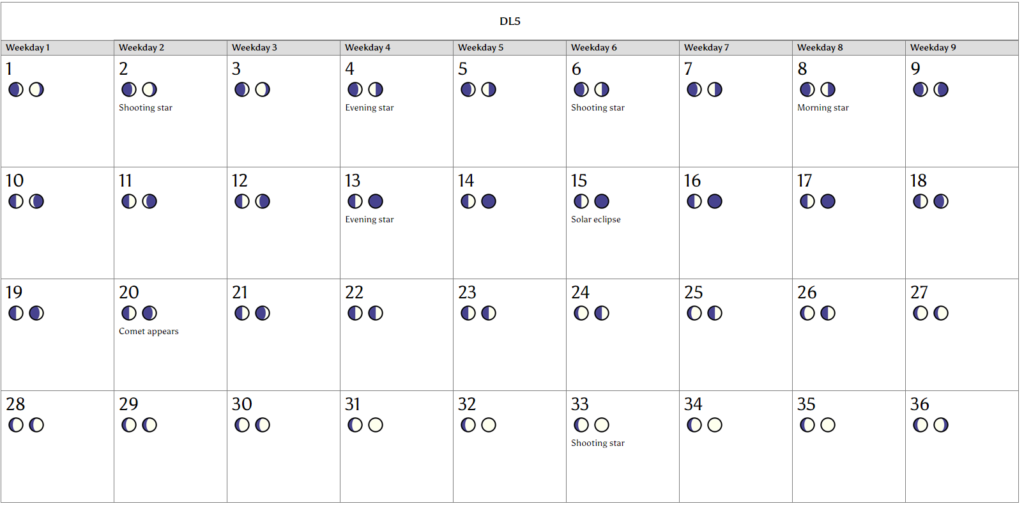The purpose of a dilunisolar calendar is to simultaneously track a planet’s location relative to the sun as well as its position relative to two moons orbiting it. It may sound complicated and it may look complicated, but a calendar is just a set of rules by which we measure time. Once you know the rules, you know the system. I have created such a calendar with its own set of rules for its own planet. This planet takes place in a fantasy setting where magic is integrated heavily into reality. This planet follows a long orbit around it’s star in similar conditions to ours, but with a much longer year. Seasons are long and harsh due to the slow orbit. Orbiting the planet are two moons, one large and ever present, and the other far and distant. The two moons tell a story each year with their dances and the people have adapted to their presence. Using this premise, I have created a calendar to suit their needs and tell time in their space.
For anyone interested in the process, it is documented here:
Creating a Dilunisolar Calendar
Part 1: Design Goals
Part 2: Days, Months, Seasons, & Years
Part 3: Cultural Significance
The calendar itself, however, is just a set of rules a little more complex than our own. I have used donjon’s calendar builder to help me visualize the calendar using these rules.
The rules are as follows:
- Each year starts with 3240 days (8.8 Earth years).
- Days, Hours, Minutes, and Seconds remain the same.
- Weeks are 9 days in total, given to commemorate each of 9 different ascended gods including two for the moons. One is left out.
- Due to the importance of seasons, the year starts when Winter ends and Spring begins.
- Seasons are broken into Lunar seasons and Dilunar seasons which alternate.
- Lunar Spring, Dilunar Spring, Dilunar Summer, Lunar Summer, Lunar Autumn, Dilunar Autumn, Dilunar Winter, Lunar Winter.
- Each Season is given ten months.
- Lunar seasons have months with base 72 days and 36 days following a 108 day pattern of the lesser moon. Lunar seasons add up to 540 days.
- Dilunar seasons have months with base 36 days and 18 days following the 36 day pattern of the greater moon. Dilunar seasons add up to 270 days.
- Lunar seasons follow an exactly alternating pattern of 72/36 repeating, except the first of each season always matches last of the previous Lunar season, thereby alternating which starts first each season. Lunar Spring and Lunar Autumn start with 72 day months. Lunar Summer and Lunar Winter start with 36 day months.
- The Lunar months track the lesser moon, whose apogee partially coincides with its New Moon.
- A 72 day Lunar month is when the lesser moon is both visible and close.
- A 36 day Lunar month is when the lesser moon is dark and distant, so the measure of the greater moon is taken. When the greater moon has repeated its cycle exactly once, the lesser moon will be visible and close again.
- The Dilunar months track the greater moon, whose cycle alternates more visibly than the lesser moon.
- Dilunar Spring and Dilunar Autumn share a pattern of 18 – 36 – 36 – 18 – 36 – 36 – 18 – 18 – 36 – 18 for their days.
- Dilunar Summer and Dilunar Winter share a different pattern of 36 – 18 – 18 – 36 – 36 – 18 – 36 – 18 – 36 – 18 for their days.
- The greater moon has a cycle of 36.08 (7.20 extra days per year) days or approximately 4 weeks.
- The lesser moon has a cycle of 108.16 (4.80 extra days per year) days or approximately 12 weeks.
- Leap year days are appended to the end of Lunar Winter.
- Every third year, an additional ten days are added for leap year.
- Except every twenty years where this number is only nine extra days.
- Except for every fifth set of twenty years (100 years) which would have ten extra days.
- Except twice on every twenty-fifth set of twenty years (500 years) which would instead have 8 days.
- Every 9 years, 108 days – each leap day in those 9 years is put into a a leap month to allow the moons to re-synchronize.
- There are 412.5 days, or 5.15 days per month, still to be added based on historical and cultural significance. These days are meant to be in the calendar, but are not yet so that they can be added with purpose as the world is more developed rather than randomly currently. This means that the 18/36/72 day structure of each month and the perfect division into weeks will not remain intact. While the moons will remain nearly perfect with the weeks, the months will not. Some months will have fewer days and others will have variable amounts of more days.
A base version of the calendar can be broken down like this:
To input this into the donjon calendar calculator, each season will need to be calculated individually. These are the inputs required to accurately get a visual calendar:




And that’s it! The Dilunisolar Calendar is completed. Well, almost. There’s still a lot of naming to do and narrative exposition and placing of those 400 or so days. I’ve also got to make a full visual calendar. Using donjon to map out 8 different calendars for each year is not exactly efficient. But I’m happy with it as a base system. I learned a lot throughout this process. Is this world physically possible? Almost certainly not. I know enough about physics and astronomy to know that there’s too many elements I haven’t considered. Also the existence of magic. But given that, is this plausible? I believe it is. Perhaps there is too much math for a narrative experience or maybe some of my math is incorrect. But now I have a calendar that works for me, a deeper understanding of calendars, and a lot more development on my world. That’s good enough for me.
